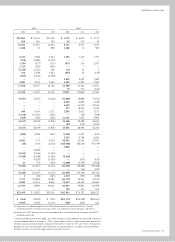GE 2012 Annual Report Download - page 68
Download and view the complete annual report
Please find page 68 of the 2012 GE annual report below. You can navigate through the pages in the report by either clicking on the pages listed below, or by using the keyword search tool below to find specific information within the annual report.management’s discussion and analsis
66 GE 2012 ANNUAL REPORT
We review identified intangible assets with defined use-
ful lives and subject to amortization for impairment whenever
events or changes in circumstances indicate that the related
carrying amounts may not be recoverable. Determining whether
an impairment loss occurred requires comparing the carrying
amount to the sum of undiscounted cash flows expected to be
generated by the asset. We test intangible assets with indefinite
lives annually for impairment using a fair value method such as
discounted cash flows. For our insurance activities remaining in
continuing operations, we periodically test for impairment our
deferred acquisition costs and present value of future profits.
Further information is provided in the Financial Resources and
Liquidity—Goodwill and Other Intangible Assets section and in
Notes 1 and 8.
PENSION ASSUMPTIONS are significant inputs to the actuarial
models that measure pension benefit obligations and related
effects on operations. Two assumptions—discount rate and
expected return on assets—are important elements of plan
expense and asset/liability measurement. We evaluate these
critical assumptions at least annually on a plan and country-
specific basis. We periodically evaluate other assumptions
involving demographic factors, such as retirement age, mortality
and turnover, and update them to reflect our experience and
expectations for the future. Actual results in any given year will
often differ from actuarial assumptions because of economic and
other factors.
Accumulated and projected benefit obligations are measured
as the present value of expected payments. We discount those
cash payments using the weighted average of market-observed
yields for high-quality fixed-income securities with maturities
that correspond to the payment of benefits. Lower discount rates
increase present values and subsequent-year pension expense;
higher discount rates decrease present values and subsequent-
year pension expense.
Our discount rates for principal pension plans at December 31,
2012, 2011 and 2010 were 3.96%, 4.21% and 5.28%, respectively,
reflecting market interest rates.
To determine the expected long-term rate of return on pen-
sion plan assets, we consider current and target asset allocations,
as well as historical and expected returns on various categories
of plan assets. In developing future long-term return expecta-
tions for our principal benefit plans’ assets, we formulate views
on the future economic environment, both in the U.S. and abroad.
We evaluate general market trends and historical relationships
among a number of key variables that impact asset class returns
such as expected earnings growth, inflation, valuations, yields
and spreads, using both internal and external sources. We also
take into account expected volatility by asset class and diversi-
fication across classes to determine expected overall portfolio
results given current and target allocations. Assets in our princi-
pal pension plans earned 11.7% in 2012, and had average annual
earnings of 7.2%, 6.1% and 8.9% per year in the 10-, 15- and
25-year periods ended December 31, 2012, respectively. These
average historical returns were significantly affected by invest-
ment losses in 2008. Based on our analysis of future expectations
of asset performance, past return results, and our current and
target asset allocations, we have assumed an 8.0% long-term
expected return on those assets for cost recognition in 2013
compared to 8.0% in both 2012 and 2011 and 8.5% in 2010.
Changes in key assumptions for our principal pension plans
would have the following effects.
Þ Discount rate—A 25 basis point increase in discount rate
would decrease pension cost in the following year by $0.2 bil-
lion and would decrease the pension benefit obligation at
year-end by about $2.0 billion.
Þ Expected return on assets—A 50 basis point decrease in the
expected return on assets would increase pension cost in
the following year by $0.2 billion.
Further information on our pension plans is provided in the
Operations—Overview section and in Note 12.
INCOME TAXES. Our annual tax rate is based on our income, statu-
tory tax rates and tax planning opportunities available to us in the
various jurisdictions in which we operate. Tax laws are complex
and subject to different interpretations by the taxpayer and
respective governmental taxing authorities. Significant judgment
is required in determining our tax expense and in evaluating our
tax positions, including evaluating uncertainties. We review our
tax positions quarterly and adjust the balances as new informa-
tion becomes available. Our income tax rate is significantly
affected by the tax rate on our global operations. In addition to
local country tax laws and regulations, this rate depends on the
extent earnings are indefinitely reinvested outside the United
States. Indefinite reinvestment is determined by management’s
judgment about and intentions concerning the future operations
of the Company. At December 31, 2012 and 2011, approximately
$108 billion and $102 billion of earnings, respectively, have been
indefinitely reinvested outside the United States. Most of these
earnings have been reinvested in active non-U.S. business opera-
tions, and we do not intend to repatriate these earnings to fund
U.S. operations. Because of the availability of U.S. foreign tax
credits, it is not practicable to determine the U.S. federal income
tax liability that would be payable if such earnings were not
reinvested indefinitely. Deferred income tax assets represent
amounts available to reduce income taxes payable on taxable
income in future years. Such assets arise because of temporary
differences between the financial reporting and tax bases of
assets and liabilities, as well as from net operating loss and tax
























